Settings
This section covers Portal role, permissions and some settings.
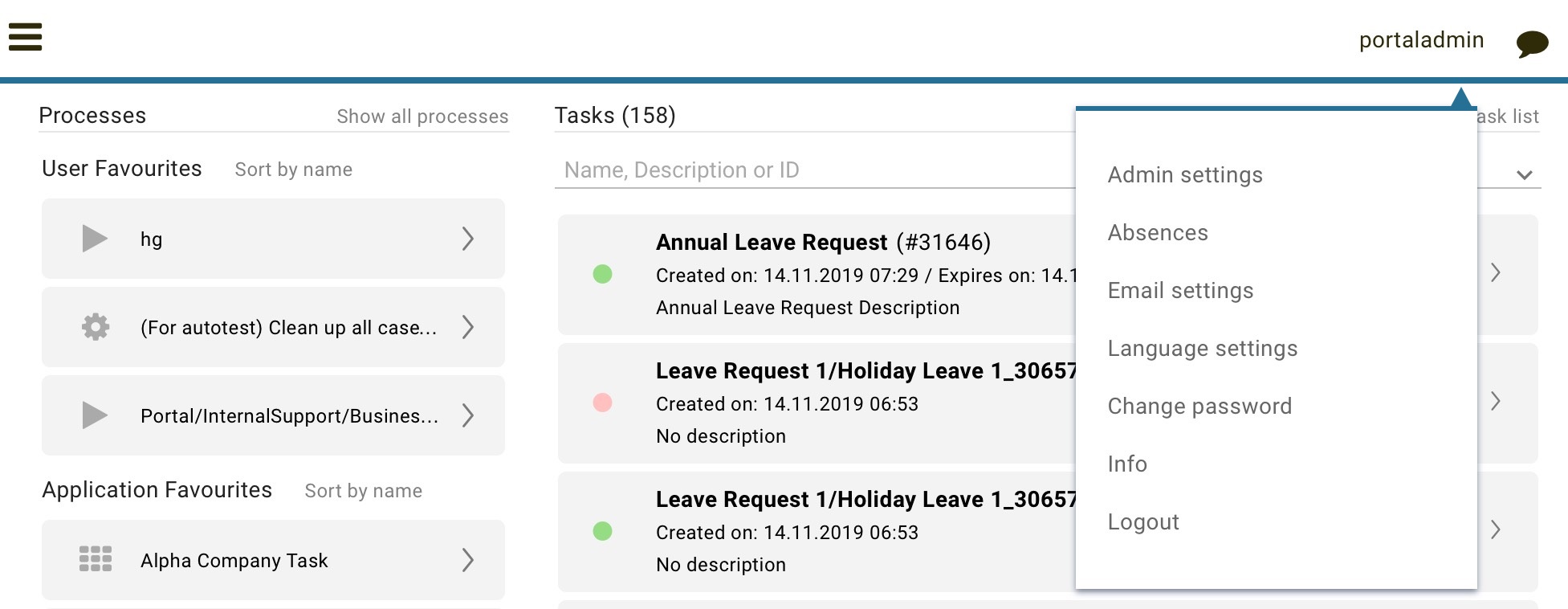
Setup Portal settings by configuration file in Designer
To manually configure Portal settings, refer to HowTo: Update Portal settings.
In development, it is a quite tedious task to configure Portal settings after restarting Designer. Therefore, Portal supports modification of Portal settings in Designer by configuration file, it could survive after restarting Designer.
Process developer can set up Portal settings of Portal in file portal_settings_config.properties which put in PortalKit.
# This file is for developer configure values for Portal settings. # As developer, you only need to remove comment mark of corresponding settings and modify their values. # Portal will apply setting values once you start designer. # System tasks visibility #HIDE_SYSTEM_TASKS_FROM_HISTORY = true #HIDE_SYSTEM_TASKS_FROM_HISTORY_ADMINISTRATOR = false #System notes visibility #HIDE_SYSTEM_NOTES_FROM_HISTORY = true #HIDE_SYSTEM_NOTES_FROM_HISTORY_ADMINISTRATOR = false # Portal chat settings #ENABLE_GROUP_CHAT = false #ENABLE_PRIVATE_CHAT = false #CHAT_RESPONSE_TIMEOUT = #CHAT_MAX_CONNECTION = 3 # Documents security settings #ENABLE_SCRIPT_CHECKING_FOR_UPLOADED_DOCUMENT = false #ENABLE_VIRUS_SCANNER_FOR_UPLOADED_DOCUMENT = false #UPLOAD_DOCUMENT_WHITELIST_EXTENSION = doc, docx, xls, xlsx, xlsm, csv, pdf, ppt, pptx, txt, zip, jpg, jpeg, bmp, png # Time settings #HIDE_TIME = false #CLIENT_SIDE_TIMEOUT = #REFRESH_TASK_LIST_INTERVAL = 10000 # Filter Settings #DATE_FILTER_WITH_TIME = false # Task/case counting functions #DISABLE_CASE_COUNT = false #DISABLE_TASK_COUNT = false # IFrame setting #EMBED_IN_FRAME = true # Logged in user format, available values: USERNAME, DISPLAY_NAME, DISPLAY_NAME_USERNAME, USERNAME_DISPLAYNAME #LOGGED_IN_USER_FORMAT = DISPLAY_NAME # Task/case detail document component setting #HIDE_TASK_DOCUMENT = false #HIDE_CASE_DOCUMENT = false # Others #HOMEPAGE_URL = #SHOW_ENVIRONMENT_INFO = false #ENABLE_CASE_OWNER = false #EXPRESS_END_PAGE = true #HIDE_CHANGE_PASSWORD_BUTTON = false #HIDE_LOGOUT_BUTTON = false #HIDE_UPLOAD_DOCUMENT_FOR_DONE_CASE = false #HIDE_STATISTIC_WIDGET = false #ENABLE_USER_FAVORITES = true #DISPLAY_MESSAGE_AFTER_FINISH_TASK = true #SHOW_GLOBAL_SEARCH = true
This file already contains list of settings with their default values. These settings will be applied once you start Portal.
If you change configuration file while coding, please stop engine in designer and start engine again to apply changes.
Setup Portal multi applications
Portal provides two types of multi applications: Multi applications with overview and Multi applications (without overview)
Multi applications with overview
Important
Used for related applications App1, App2, App3… of which we need to see all
tasks/cases in one page. Task/Case list of application named Portal would display all
tasks/cases of applications App1, App2, App3…
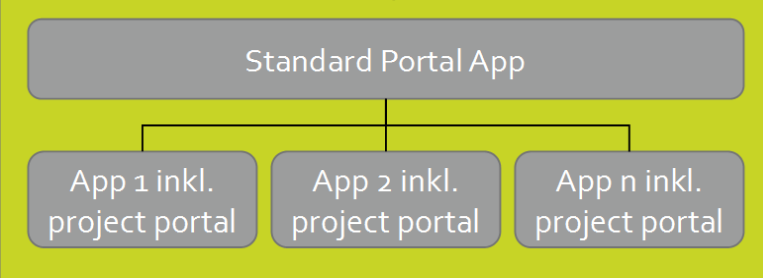
Create a new application named
Portal. Deploy Portal (Kit, Template ..) to this application.Create new applications: App1, App2, App3… Deploy Portal (Kit, Template ..) to new applications.
Configure multi-apps Portal: login by Portal Admin, configure applications: App1, App2, App3…
Note that,
do notadd the application namedPortal, it is reserved for displaying all tasks/cases… from all configured applications.Dashboard menu is only visible when logged-in user exists in Portal application.
Multi applications (without overview)
Important
Used for independent applications App1, App2, App3… of which we do not need to see all
tasks/cases in one page.

Create new applications: App1, App2, App3… Deploy Portal (Kit, Template …) to new applications. Note: must not create an application named
Portal.Configure multi-apps Portal: login by Portal Admin, configure applications: App1, App2, App3…
Language settings
Below is applied language setting precedence:
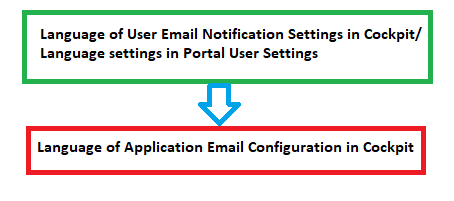
If user email language setting is application default, language would be applied by application email language setting.
If user selects a language in email setting, language would be appplied by this selection.
To configure languages of Portal applications, select
Language SettingsinUser Settings.UI reads current languages settings for all applications.
To change language for application, select one in the languages dropdown list of application. When the change is saved, the language will be set for application (Click on the application in header menu to reload application and see the change of language).
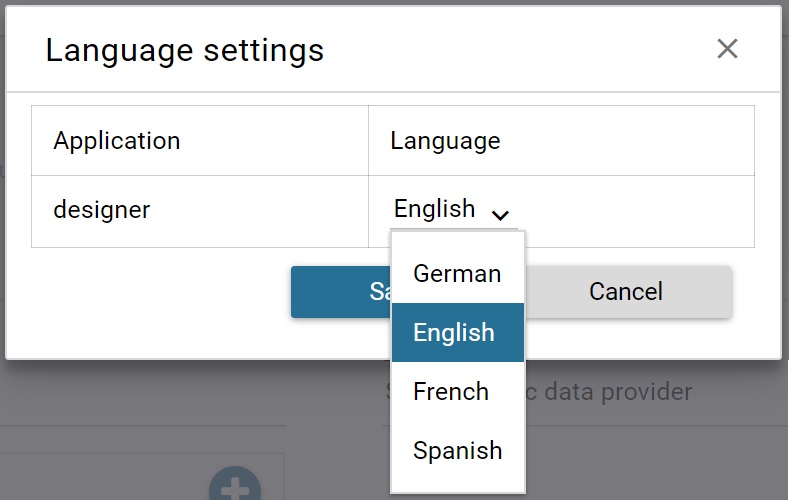
For multiple languages, the CMS key
/AppInfo/SupportedLanguagesmust exist in your application. From Portal 7.1, this CMS entry is moved to Portal Style. It contains list of all languages supported by your application, separated by comma.Must not contain spaces
Same as display name of Locale
Separated by comma
Process model version, which has this CMS, must active
To add new language to Portal, what you have to do is
Open CMS item
/AppInfo/SupportedLanguagesin Portal Style, then add new language for example Italian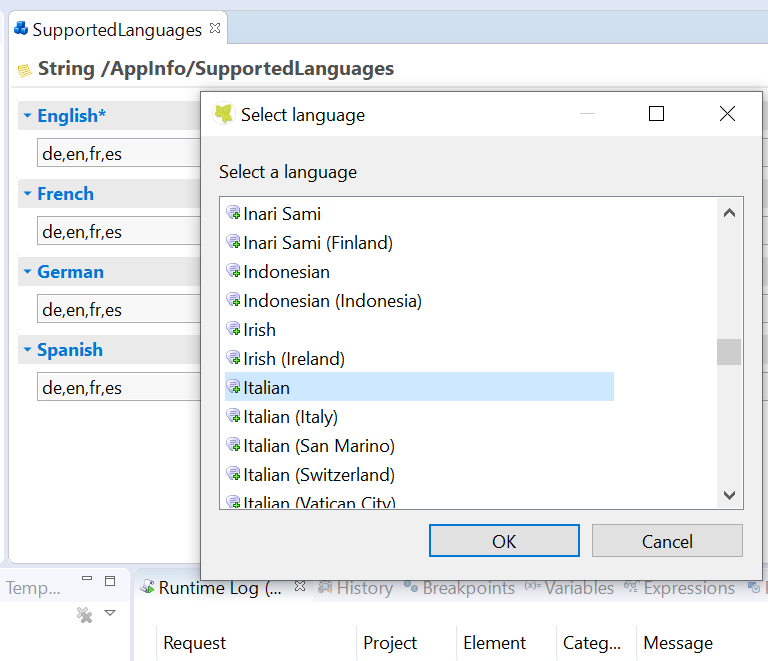
Add new language locale to all items, you can input either language code
itor language code with countryit-CH. If you use language code with country, refer to Java supported locales .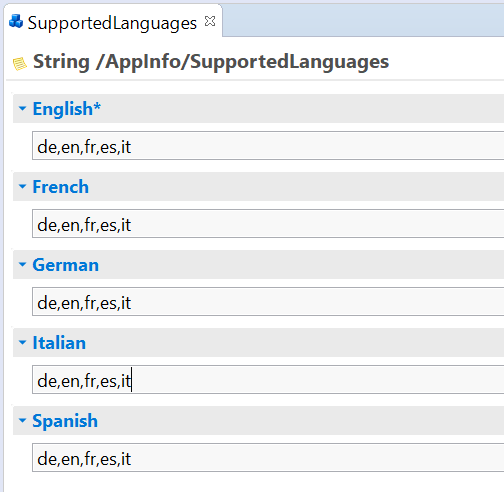
Export all CMS entries of Portal Style to excel file then add translation of new language for all CMS entries
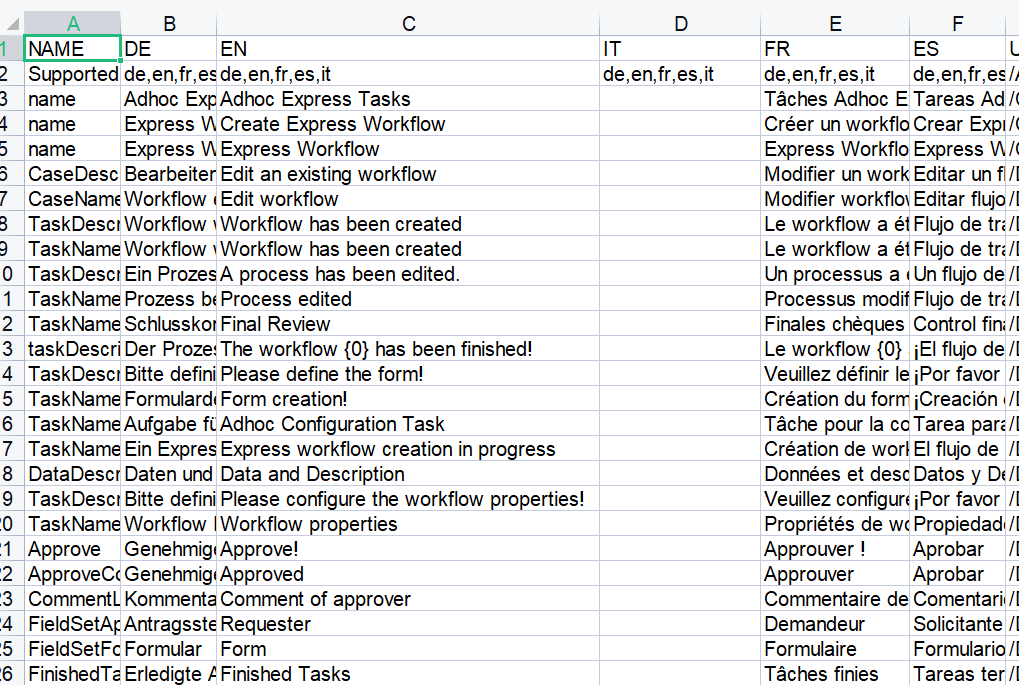
Import file excel back.
Redeploy Portal Style.
Role configuration
PortalKit roles |
Rights |
|---|---|
AXONIVY_PORTAL_ADMIN |
User belong to this role can handle AdminUI page, configure the internal role properties, create public filters. Users who own this role need some permissions. |
Permission settings
Permissions can be configured in Cockpit. In the security area, you will find all these permission in the Group “PortalPermissions”
Absences
READ
This function will be disabled if session user does not have
IPermission.USER_READ_OWN_ABSENCESandIPermission.USER_READ_ABSENCES.CREATE/MODIFY
This function will be disabled if session user does not have
IPermission.USER_CREATE_OWN_ABSENCEandIPermission.USER_CREATE_ABSENCE.DELETE
This function will be disabled if session user does not have
IPermission.USER_DELETE_OWN_ABSENCEandIPermission.USER_DELETE_ABSENCE.MANAGE EVERY USER ABSENCES
User can read, add, delete absences of all users. This function will be disabled if session user does not have all of the following permissions:
IPermission.USER_CREATE_ABSENCE,IPermission.USER_DELETE_ABSENCE,IPermission.USER_READ_ABSENCES.
Substitute
CREATE OWN SUBSTITUTE
This function will be disabled if session user does not have
IPermission.USER_CREATE_OWN_SUBSTITUTEandIPermission.USER_CREATE_SUBSTITUTE.MANAGE EVERY USER SUBSTITUTES
This function will be disabled if session user does not have
IPermission.USER_CREATE_SUBSTITUTEorIPermission.USER_READ_SUBSTITUTES.
Personal task permission
ADD NOTE
Refer to Display add note button.
DELEGATE
User can delegate his personal or group tasks if he has permission
TaskWriteActivatorOwnTasks(This permission belongs to Portal permission group and it is not assigned to role Everybody by default). User can delegate all the tasks he see in his task list if he has permissionIPermission.TASK_WRITE_ACTIVATOR.Important
Task state cannot be one of the following values: CREATED, DONE, DESTROYED, RESUMED, FAILED.
This function will be hidden if session user does not have permission
PortalPermission.TASK_DISPLAY_DELEGATE_ACTION.RESET
This function will be enabled if session user has permission
IPermission.TASK_RESET_OWN_WORKING_TASKorPortalPermission.TASK_RESET_READY_FOR_JOINorIPermission.TASK_RESET.Important
Task state has to be one of following values: RESUMED, PARKED, READY_FOR_JOIN.
This function will be hidden if session user does not have permission
PortalPermission.TASK_DISPLAY_RESET_ACTION.DELETE TASK
Delete task function will be enabled if session user has
IPermission.TASK_DESTROY.Important
Task state hasn’t to be in DESTROYED and DONE.
RESERVE
This function will be enabled if session user has permission
IPermission.TASK_PARK_OWN_WORKING_TASK.Important
Task state has to be one of following values: CREATED, RESUMED, SUSPENDED.
This function will be hidden if session user does not have permission
PortalPermission.TASK_DISPLAY_RESERVE_ACTION.CHANGE TASK NAME
This function will be enabled if session user has
IPermission.TASK_WRITE_NAME.Important
Task state cannot be one of following values: DONE, DESTROYED, FAILED.
CHANGE TASK DESCRIPTION
This function will be enabled if session user has
IPermission.TASK_WRITE_DESCRIPTION.Important
Task state cannot be one of following values: DONE, DESTROYED, FAILED.
CHANGE DEADLINE
This function will be enabled if session user has
IPermission.TASK_WRITE_EXPIRY_TIMESTAMP.Important
Task state cannot be one of following values: DONE, DESTROYED, FAILED.
CHANGE PRIORITY
This function will be disabled if session user does not have
IPermission.TASK_WRITE_ORIGINAL_PRIORITY.Important
Task state cannot be one of following values: DONE, DESTROYED, FAILED.
DISPLAY ADDITIONAL OPTIONS
This function will be hidden if session user does not have permission
PortalPermission.TASK_DISPLAY_ADDITIONAL_OPTIONS.
Personal case permission
ADD NOTE
Refer to Display add note button.
DELETE CASE
Delete case function will be enabled if session user has
IPermission.CASE_DESTROY.Important
Case state has to be RUNNING.
CHANGE CASE NAME
Change case name function will be enabled if session user has
IPermission.CASE_WRITE_NAME.Important
Case state cannot be DONE, DESTROYED.
CHANGE CASE DESCRIPTION
Change case description function will be enabled if session user has
IPermission.CASE_WRITE_DESCRIPTION.Important
Case state cannot be DESTROYED.
SEE RELATED TASKS OF CASE
Session user can see all related tasks of case if he has
IPermission.TASK_READ_OWN_CASE_TASKSorIPermission.TASK_READ_ALL.Important
Case state cannot be DESTROYED.
Link to show all tasks of case will be hidden if session user does not have permission
PortalPermission.SHOW_ALL_TASKS_OF_CASE.DISPLAY SHOW DETAILS LINK
This link will be hidden if session user does not have permission
PortalPermission.SHOW_CASE_DETAILS. This permission is not assigned to role Everybody by default.
Upload/delete document permission
Upload/delete document function will be enabled if session user has
IPermission.DOCUMENT_WRITE or
IPermission.DOCUMENT_OF_INVOLVED_CASE_WRITE.
Express Workflow permission
CREATE EXPRESS WORKFLOW
Create Express Workflow function will be enabled if session user has
PortalPermission.EXPRESS_CREATE_WORKFLOW(This permission belongs to Portal permission group, assigned to role Everybody by default).
Statistics permission
ADD DASHBOARD CHART
Add new charts function will be enabled if session user has
PortalPermission.STATISTIC_ADD_DASHBOARD_CHART(This permission belongs to Portal permission group, assigned to role Everybody by default).ANALYZE TASK
Filter tasks and export data to excel for advanced analysis. This function will be enabled if session user has
PortalPermission.STATISTIC_ANALYZE_TASK(This permission belongs to Portal permission group and it is not assigned to role Everybody by default).
Portal general permission
ACCESS TO FULL PROCESS LIST
User cannot see “Processes” on the left menu and link “Show all processes” (on Dashboard) if he does not have permission
PortalPermission.ACCESS_FULL_PROCESS_LIST.ACCESS TO FULL TASK LIST
User cannot see “Tasks” on the left menu and link “Show full task list” (on Dashboard) if he does not have permission
PortalPermission.ACCESS_FULL_TASK_LIST.ACCESS TO FULL CASE LIST
User cannot see “Cases” on the left menu if he does not have permission
PortalPermission.ACCESS_FULL_CASE_LIST.ACCESS TO FULL STATISTIC LIST
User cannot see “Statistics” on the left menu and link “Show all charts” (on Dashboard) if he does not have permission
PortalPermission.ACCESS_FULL_STATISTICS_LIST.DISPLAY SHOW MORE NOTE BUTTON
This button will be hidden if session user does not have permission
PortalPermission.TASK_CASE_SHOW_MORE_NOTE.CREATE PUBLIC EXTERNAL LINK FOR ALL USERS
Everyone can add a new external link privately by default. If a user is granted
PortalPermission.CREATE_PUBLIC_EXTERNAL_LINK, he can set an external link as public so that all other users can see this link in full process list and other users can also add it to User Favorites.
Administrator permission can see all tasks/cases in the application
Normal users can only see their tasks/cases they can work on.
Administrator can see all tasks/cases in the application.
Permissions needed: IPermission.TASK_READ_ALL,
IPermission.CASE_READ_ALL.
Administrator permission can interact with all workflows in the application
Normal users can updates and deletes workflows which created by him and can interact with workflow’s task which assigned to him.
Administrator can creates, updates and deletes all workflows in the application.
Virus Scanning Setting
PrimeFaces is delivered with one implementation of that interface that uses VirusTotal. To enable VirusTotal you need to create a community account at the VirusTotal website. You receive an API key once you have an account. To configure the API key add the following snippet to the webapps/ivy/WEB-INF/web.xml file:
<context-param> <param-name>primefaces.virusscan.VIRUSTOTAL_KEY</param-name> <param-value>PUT YOUR API KEY HERE</param-value> </context-param>
By default after configured context-param in the web XML file, the Virus
Scanning is disabled. You could update the value of the variable
ENABLE_VIRUS_SCANNER_FOR_UPLOADED_DOCUMENT to true in
portal_settings_config.properties that you want to enable.
Reference: How to check if uploaded files contain a virus.
Global variables
Variable |
Default value |
Description |
|---|---|---|
PortalStartTimeCleanObsoletedDataExpression |
0 0 6 * * ? |
Cron expression define
the time to clean up data
of obsoleted users. E.g.:
expression for at 6AM
every day is
|
PortalDeleteAllFinishedHiddenCases |
false |
If set to |
PortalHiddenTaskCaseExcluded |
true |
By default, Portal will
query tasks and cases
which don’t have hide
information. Set it to
|